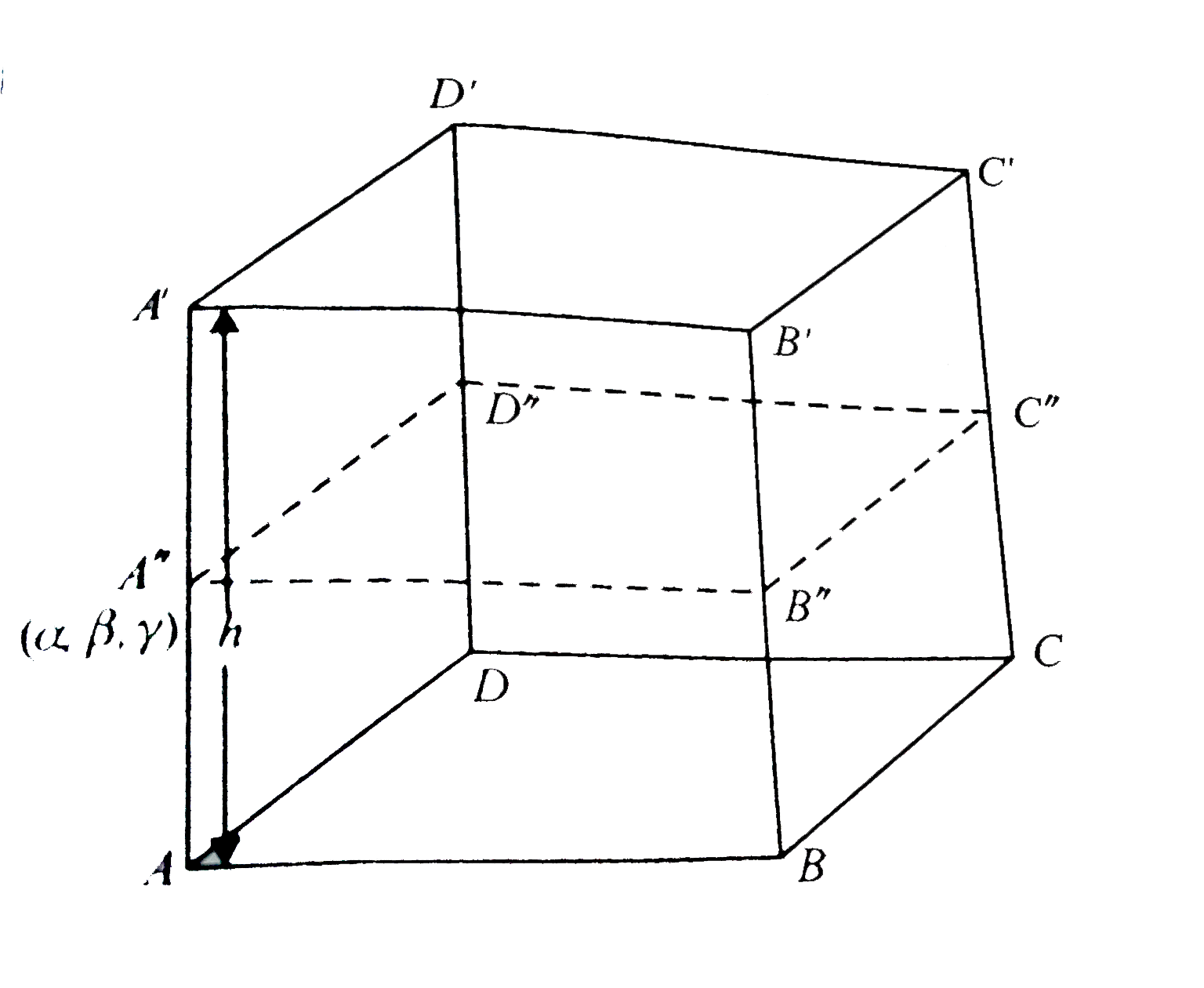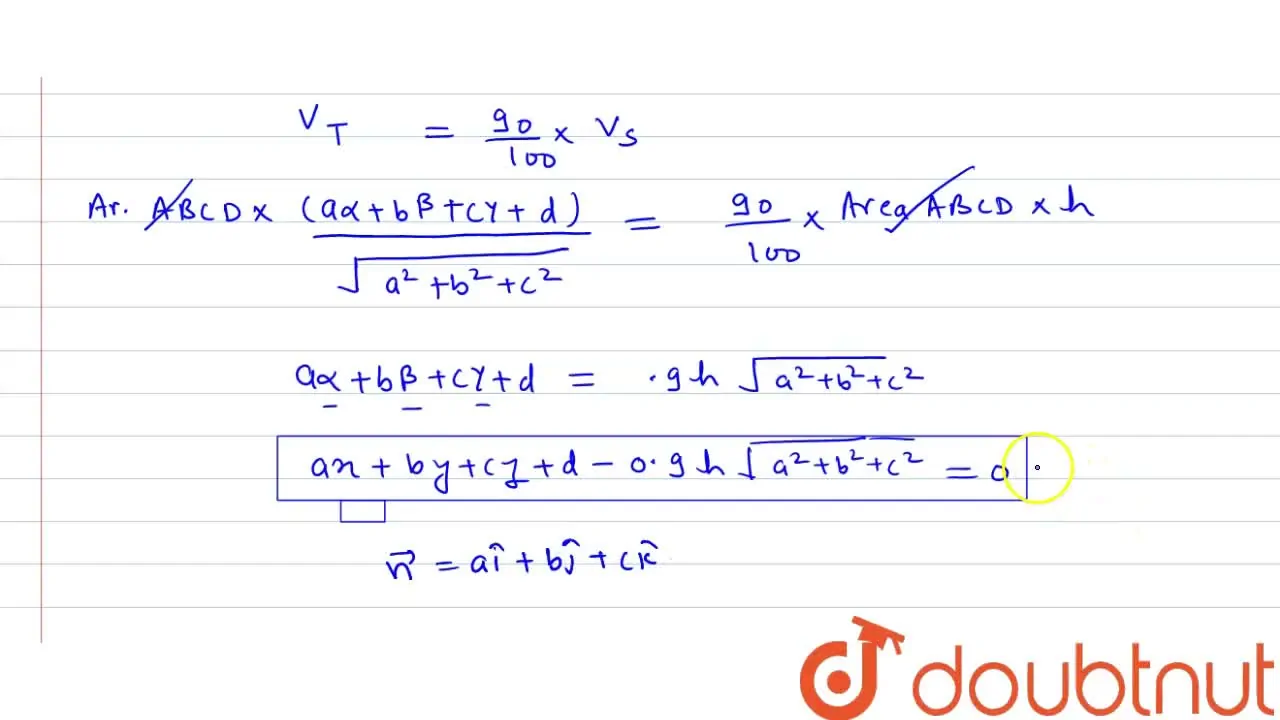A parallelepiped S has base points A,B,CandD and upper face points A′,B′,C′,andD' . The parallelepiped is compressed by upper face A'B'C'D' to form a new parallepiped T having upper face points A,B,Ca n dD . The volume of parallelepiped T is 90 percent of the volume of parallelepiped S. Prove that the locus of A is a plane.
S is the parallelepiped with base point A,B,CandD and upper face points A',B',C'andD'. Let its volume ve Vs. By compressing it by upper face A',B',C'andD', a new parallelepiped T is formed whose upper face points are now A'',B'',C''andD''. Let its volume be VT.
Let h be the height of original parallelepiped S. Then
VS=(area of ABCD)×h (i)
Let equation of plane ABCD be ax+by+cz+d=0andA''(α,β,γ).

Then the height of the new parallelepiped T is the length of the perpendicular from A'' to ABCD, i.e., aα+η+cγ+d√a2+b2+c2. Therefore
VT=(ar ABCD)×(aα+η+cγ+d)√a2+b2+c2 (ii)
But given that VT=90100Vs (iii)
From (i), (ii) and (iii), we get
aα+η+cγ+d√a2+b2+c2=0.9h
or aα+η+cγ+d−0.9h√a2+b2+c2=0
Therefore, the locus of A''(α,β,γ) is ax+by+cz+d−0.9h√a2+b2+c2=0, which is a plane parallel to ABCD. Hence proved.
Related Playlists
- BOOK - CENGAGE ENGLISHCHAPTER - THREE-DIMENSIONAL GEOMETRY EXERCISE - ARCHIVES SINGLE CORRECT ANSWER TYPE9videos
THREE-DIMENSIONAL GEOMETRY
- BOOK - CENGAGE ENGLISHCHAPTER - THREE-DIMENSIONAL GEOMETRY EXERCISE - ARCHIVES MULTIPLE CORRECT ANSWERS TYPE4videos
THREE-DIMENSIONAL GEOMETRY
- BOOK - CENGAGE ENGLISHCHAPTER - THREE-DIMENSIONAL GEOMETRY EXERCISE - INTEGER TYPE10videos
THREE-DIMENSIONAL GEOMETRY
- BOOK - CENGAGE ENGLISHCHAPTER - THREE DIMENSIONAL GEOMETRYEXERCISE - All Questions294videos
THREE DIMENSIONAL GEOMETRY
- BOOK - CENGAGE ENGLISHCHAPTER - TRIGONOMETRIC EQUATIONSEXERCISE - Archives (Matrix Match Type)1videos
TRIGONOMETRIC EQUATIONS
Similar Questions
A parallelepiped S has base points A,B,CandD and upper face points A′,B′,C′,andD' . The parallelepiped is compressed by upper face A'B'C'D' to form a new parallepiped T having upper face points A'',B'',C''and D'' . The volume of parallelepiped T is 90 percent of the volume of parallelepiped S. Prove that the locus of A is a plane.
View SolutionA parallelepiped is formed by planes drawn parallel to coordinate axes through the points A=(1,2,3) and B=(9,8,5). The volume of that parallelepiped is equal to (in cubic units)
View SolutionFid the condition if lines x=ay+b,z=cy+dandx=a′y+b′,z=c′y+d' are perpendicular.
View SolutionFid the condition if lines x=ay+b,z=cy+dandx=a′y+b′,z=c′y+d' are perpendicular.
View SolutionFid the condition if lines x=ay+b,z=cy+dandx=a′y+b′,z=c′y+d' are perpendicular.
View SolutionA parallelepiped is formed by planes drawn through the points (2, 3, 5) and (5, 9, 7), parallel to the coordinate lanes. The length of a diagonal of the parallelepiped is a. 7 b. √38 c. √155 d. none of these
View SolutionProve that the points (a,b+c),(b,c+a)and(c,a+b) are collinear.
View SolutionA rectangular parallelepiped is formed by planes drawn through the points (5, 7, 9) and (2, 3, 7) parallel to the coordinate planes. The length of an edge of this rectangular parallelepiped is a. 2 b. 3 c. 4 d. all of these
View SolutionProve that the line x=ay+b, z=cy+d and x=a′y+b′, z=c′y+d′ are perpendicular if aa′ +cc′+ 1=0
View SolutionUsing determinants prove that the points (a, b), (a′, b′)and (a−a′, b−b′) are collinear if ab′=a′b.
View Solution


